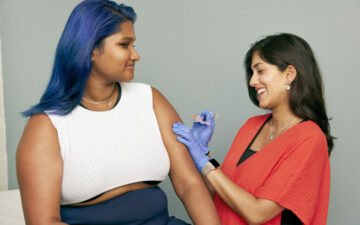A snapshot of breast cancer in North Carolina, by the data

Breast cancer is the most diagnosed cancer in women and second leading cause of cancer-related death after lung cancer. One in eight women will be diagnosed with breast cancer within their lifetime, and one in 43 will die from breast cancer, according to analyzes by the American Cancer Society. The North Carolina Department of Health and Human Services (NCDHHS) reports that in North Carolina each year more than 8,000 women are diagnosed with cancer and about 1,000 women die of cancer. This blog post will present state trends and county differences in breast cancer screening, diagnoses (incidence), and mortality among women in North Carolina.
It is recommended that women over 40 (or those who have a higher risk of developing breast cancer) get a mammogram every one to two years. In North Carolina in 2022, about 72% of women over 40 said that they had had a mammogram sometime in the last two years.
There are large disparities in screening by race and ethnicity. Non-Hispanic Black women reported the highest screening rates (78%) followed by non-Hispanic white women (71%). American Indian/Alaska Native women reported the second lowest screening rates (62%) and Hispanic women reported the lowest screening rates in 2022 (58%). Screening rates also differ among North Carolina’s 100 counties. The highest screening rates were in Burke, Union, Catawba, Macon, and Scotland counties (all around 80%). The lowest screening rates in 2022 were in Greene, Iredell, Tyrrell, Stanly, and Pitt (61% or less). Sixty-three counties had screening rates lower than the state average.
Incidence rates, or the number of women diagnosed with breast cancer per 100,000 women (adjusted for age structure for comparison) also differ by race and ethnicity.
Black women and white women had the highest breast cancer incidence rates over the past two decades. Black women and white women follow the overall trend among women in North Carolina which shows that diagnoses have generally increased (note that these racial groups are also the largest in North Carolina and likely to drive the overall rates). Asian or Pacific Islander women had the lowest rates in 2021 in North Carolina followed by Hispanic women and American Indian/Alaska Native women. Among all demographic groups in 2021 except for Asian or Pacific Islander women, more than 100 women per 100,000 women were diagnosed with breast cancer.
Incidence rates also differ by age: older women are more likely to be diagnosed with breast cancer than younger women. There has been an uptick in the incidence rates among women younger than 50 in the past 20 years (from 43 women per 100,000 in 2002 to 53 per 100,000 in 2021). However, the incidence rate among women under 50 years old in 2021 was also almost eight times lower (53 per 100,000) than the incidence rate among women 50 years old or older (389 per 100,000).
Breast cancer incidence rates differ between counties, too. In North Carolina overall, in the latest released data by the National Cancer Institute, 143 women per 100,000 were diagnosed with breast cancer. Thirty-three of North Carolina’s 100 counties had incidence rates higher than the overall rate in North Carolina. The counties with the largest number of women diagnosed with breast cancer per 100,000 were Jones, Anson, Person, Martin, and Pitt (above 160 per 100,000). The counties with the smallest number of women diagnosed with breast cancer per 100,000 women were Hyde, Ashe, Swain, Currituck, and Gates (below 100 per 100,000).
In the U.S. and in North Carolina, breast cancer is the second leading cause of death due to cancer among women - second only to lung cancer. In North Carolina in 2022 the mortality rate of breast cancer, or the number of women per 100,00 who died of breast cancer, was 19 women per 100,000, down from 31 women per 100,000 in 1990. These rates differed by demographic characteristics.
The breast cancer mortality rate differs between Black non-Hispanic women and white non-Hispanic women. Consistently over the past decades, the mortality rate for Black women has been above that of white women in North Carolina. For both Black and white women, the breast cancer mortality rates have decreased, though the rate for Black women remains higher: in 1990 38 Black women per 100,000 died from breast cancer whereas in 2022, the number was 26 per 100,000. The pattern is the same for white women, in 1990, 29 white women per 100,000 died from breast cancer while in 2022, the rate was down to 18 women per 100,000.
The breast cancer mortality rate in North Carolina has declined for both women 50 and older and women younger than 50 in the last three decades. In 1990, nine out of 100,000 women under 50 died of breast cancer, and 87 out of 100,000 women over 50 died of breast cancer. In 2022, however, the rate for women under 50 had decreased to four out of 100,000 and the rate for women 50 and older had decreased to 60 women per 100,000.
The breast cancer mortality rates differ between North Carolina’s 100 counties. In North Carolina in 2022, 18 women out of 100,000 died of breast cancer. On a county level, the mortality rates ranged from 12 women per 100,000 in Bertie County to 40 women per 100,000 in Vance County. The counties with the lowest mortality rates were Bertie, Alleghany, Stokes, Lincoln, and Watauga. Bladen, Avery, Nash, Anson, and Vance were the counties with the highest mortality rates. Sixteen counties did not publish any mortality rates due to insufficient data (Camden, Caswell, Chowan, Clay, Gates, Graham, Greene, Hertford, Hyde, Montgomery, Northampton, Pamlico, Perquimans, Swain, Tyrrell, and Washington). The table below shows how breast cancer screening rates, incidence rates, and mortality rates differ by county.
The treatment of breast cancer has improved over the last decades leading to lower mortality rates among all demographic groups, although the number of women who are diagnosed with breast cancer is increasing. Inequalities exist in who is more likely to die of breast cancer if diagnosed: older women die at higher rates from breast cancer, as do women of color. There are also large disparities in the deaths from breast cancer for women of color as compared to white women. The mortality rates also differ by county, perhaps indicating less access to care in these communities. Research also shows that factors such as neighborhood socioeconomic characteristics and pollution are associated with higher rates of breast cancer, potentially explaining some of the geographical differences in breast cancer incidence rate and mortality rate.
Early detection is important, and access to screening and high-quality care may improve the chances of survival. To further combat the death rates from breast cancer and the unequal mortality rates among women of different races and ethnicities, regions in North Carolina and the state overall can work to improve women’s access to care and promote the importance of screening, especially for women over the age of 40.
Need help understanding population change and its impacts on your community or business? Carolina Demography offers demographic research tailored to your needs.
Contact us today for a free initial consultation.
Contact UsCategories: Uncategorized

The Center for Women’s Health Research (CWHR) at the University of North Carolina School of Medicine released the 12th edition of our North Carolina Women’s Health Report Card on May 9, 2022. This document is a progress report on the…

Dr. Krista Perreira is a health economist who studies disparities in health, education, and economic well-being. In collaboration with the Urban Institute, she recently co-led a study funded by the Kate B. Reynolds Foundation to study barriers to access to…

Our material helped the NC Local News Lab Fund better understand and then prioritize their funding to better serve existing and future grant recipients in North Carolina. The North Carolina Local News Lab Fund was established in 2017 to strengthen…
Your support is critical to our mission of measuring, understanding, and predicting population change and its impact. Donate to Carolina Demography today.